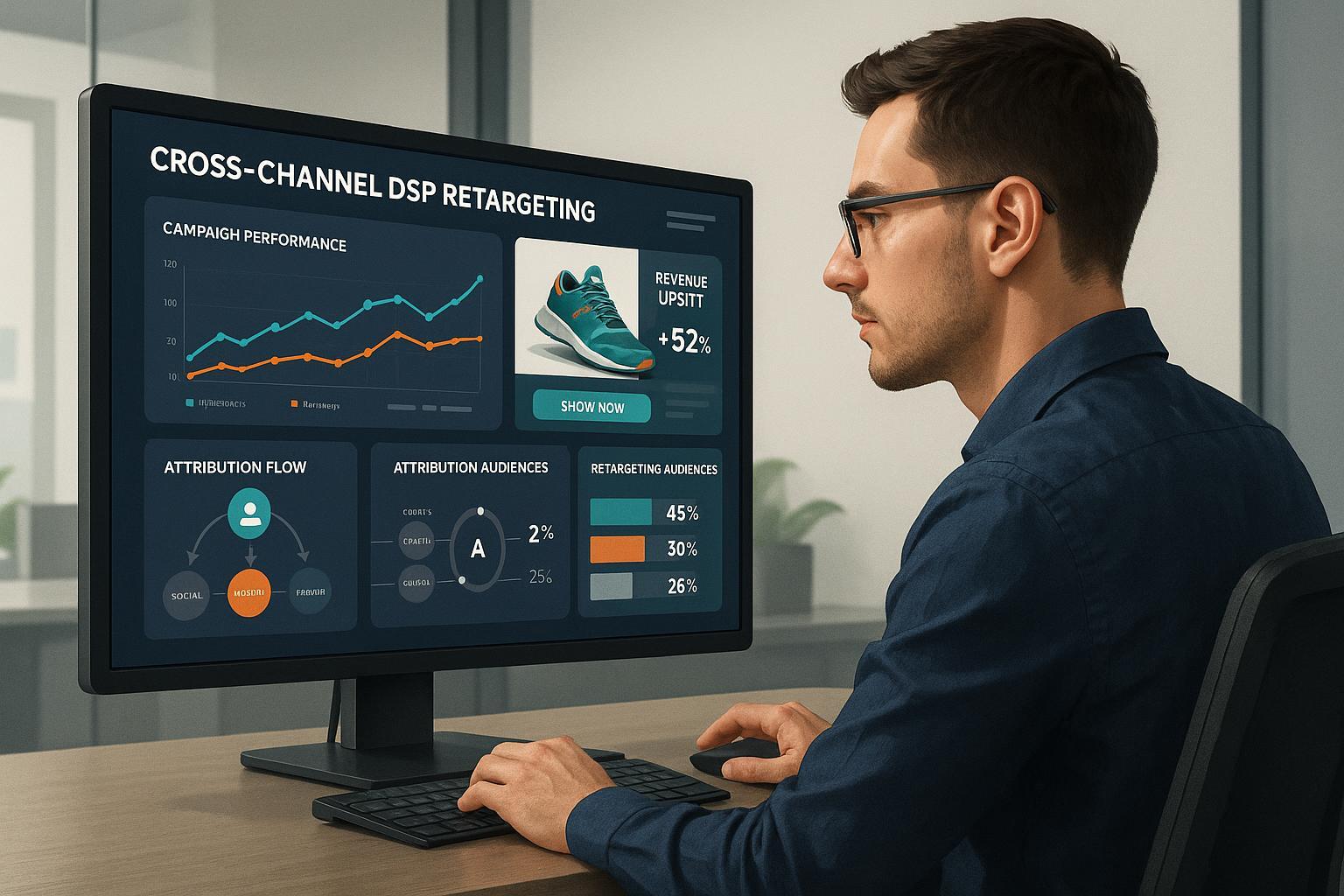Maximizing ROI with DSP Retargeting: Strategies for Success

Introduction
Struggling to quantify the true impact and optimize the return on investment (ROI) of your DSP retargeting? E-commerce marketers are investing more than ever in programmatic advertising, but most still battle with wasted spend, inaccurate attribution, fragmented analytics, and an inability to connect ad dollars directly to bottom-line sales. In a privacy-driven, post-cookie digital landscape, maximizing ROI demands more than surface-level tactics—it requires advanced measurement, granular segmentation, and automation.
This guide distills the latest, field-tested best practices—backed by quantitative results, industry benchmarks, and real Shopify/DTC use cases—to help you unleash the full potential of DSP retargeting. Whether you’re scaling multi-channel campaigns or looking to squeeze more value out of every impression, these strategies offer the blueprint for e-commerce success.
1. Implement Multi-Touch Attribution Beyond Last-Click
What/Why: Last-click attribution dramatically undervalues DSP retargeting, often ignoring the multi-step reality of today’s customer journey. Multi-touch attribution (MTA) assigns proportional credit across all campaign touchpoints—essential for identifying true ROI drivers in cross-channel e-commerce (see Gotrellis).
How: Deploy an attribution solution capable of ingesting click, view-through, and server-side events from all major DSPs and marketing channels. Platforms like Attribuly integrate seamlessly with Shopify and leading ad networks, blending server-side data for lossless accuracy. Use MTA to:
Uncover undervalued retargeting touchpoints
Optimize budget allocation between prospecting and remarketing
Distinguish between incremental and cannibalized conversions
Impact: Attribuly case: After enabling MTA, a DTC apparel brand uncovered that retargeting touchpoints influenced 2x more conversions than last-click models showed. Advanced attribution drove a 27% higher ROAS over 60 days.
2. Enable Server-Side Tracking for Data Resilience and Precision
What/Why: Pixel-based tracking is now unreliable due to browser restrictions, ad-blockers, and privacy legislation. Server-side/event-based tracking captures first-party data directly, boosting data accuracy and resilience (Viant).
How: Integrate server-side tracking through your analytics provider. Attribuly offers code-free activation for Shopify and supports event capture across all major ad platforms (Meta, Google, TikTok). This enables robust:
Cross-channel event stitching
Identity resolution to connect known and unknown users
Immune-to-browser-loss data flows
Impact: A Shopify brand using Attribuly increased their attributed ‘add-to-cart’ events from 13% to 32%, generating an extra $148,000 revenue in 30 days. Funnel drop-off went down, and tracked conversions soared.
3. Apply Granular and Predictive Segmentation
What/Why: Broad retargeting wastes budget and contributes to ad fatigue. Advanced segmentation—leveraging RFM (Recency, Frequency, Monetary), predicted LTV, and behavioral triggers—enables truly personalized journeys and higher conversion rates (StackAdapt).
How:
Segment users by behavior (abandoned checkout, high LTV, repeat buyers)
Use predictive analytics to forecast likelihood of purchase
Create funnel-stage specific audiences (e.g., awareness, consideration, loyalty)
In Attribuly, automate real-time audience creation and campaign triggers based on first-party events
Test impact via controlled holdout groups (see incrementality testing below)
Impact: Attribuly-powered campaigns using dynamic, behavior-driven segments doubled Klaviyo-generated email revenue and saw ROAS uplift of 38–100% compared to generic retargeting flows.
4. Unify Cross-Platform Data and Analytics
What/Why: Siloed channel data—Google in one dashboard, Meta in another—leads to inconsistent measurement and wasted spend. Unified analytics provide business-critical, real-time visibility for all DSP, direct-to-site, and multi-channel initiatives (see Attribuly documentation).
How:
Aggregate campaign, audience, and revenue data across every channel into a single dashboard
Use connectors or data lakes for in-depth analytics (Attribuly integrates directly with Shopify, GA4, Meta, Google, TikTok, Bing, and beyond)
Visualize ROI, conversion paths, and lifetime value across every retargeting stream
Impact: Brands saw a 30–70% reduction in lost or mis-attributed conversions post-unification. Neakasa, a DTC client, cut untracked Shopify orders in GA4 from above 30% to less than 1% through Attribuly-powered cross-channel analytics.
5. Continuously Rotate and Test Creative to Combat Ad Fatigue
What/Why: Even the best audience segmentation will lose power if creative gets stale—users tune out, and click-through/QE metrics plummet. Continuous creative refresh and split-testing are essential for DSP efficiency (Acadia).
How:
Rotate ad creatives at least every 2–4 weeks depending on spend and frequency cap data
A/B test messaging, visual formats, dynamic product displays, and CTAs
Leverage DSP (or Attribuly’s analytics) to automate reporting on winning variants
Impact: Luxe Weavers (via Trellis) drove a 38% increase in ROAS and a 72% jump in Return on Merchandising Spend by combining automated creative refresh with advanced analytics.
6. Automate Campaigns with Event-Based Triggers and AI Analytics
What/Why: Manual campaign management slows down scale and limits personalization. Automation—powered by event-based triggers and AI analytics—enables real-time optimization and ensures the right message reaches the right shopper instantly.
How:
Set up automated triggered flows for cart abandonment, price drops, back-in-stock, cross/upsells (Attribuly triggers and Klaviyo integration exemplify this framework)
Utilize AI-powered recommendations for bidding, budgeting, and creative selection
Automate performance audits and anomaly detection across campaigns
Impact: Brands leveraging automation in retargeting workflows saw a 20–50% lift in incremental conversions, and cut manual campaign management time by over 60%.
7. Run Incrementality Tests and Holdout Experiments
What/Why: Overestimating retargeting ROI due to overlapping exposures is a common pitfall. Measuring incrementality—the true net lift caused only by your DSP campaigns—is best practice (Viant).
How:
Design holdout or geo-lift groups to compare exposed vs. unexposed users
Use tools like Amazon AMC or Attribuly to track conversion and revenue uplift exclusively attributed to retargeting
Integrate findings to inform ongoing budget and channel mix
Impact: Brands that proactively ran incrementality experiments reported up to 30% more efficient spend allocation and recognized previously invisible “halo” effects across campaign types.
8. Prioritize Privacy Compliance and Post-Cookie Preparedness
What/Why: Loss of third-party cookies, changes in consent rules, and regional regulation are upending legacy retargeting. Focusing on first-party data and compliant audience building futureproofs ROI.
How:
Activate first-party data capture with server-side tracking (Attribuly makes this turn-key for Shopify)
Build consented audiences and enable opt-out flows
Monitor DSP partner compliance and data residency
Impact: Early-adopting brands avoided campaign downtime during industry privacy shifts, and saw sustained retargeting performance when others lost measurement and targeting capabilities.
Conclusion & Next Steps
By integrating multi-touch attribution, resilient server-side tracking, advanced segmentation, unified analytics, creative testing, automation, incrementality measurement, and privacy compliance, you can drive e-commerce DSP retargeting ROI to new heights. Proprietary results and case studies confirm these actions enable gains above 20–100% compared to old-school approaches.
Ready to take analytics-driven control of your retargeting ROI? Explore Attribuly for unified e-commerce analytics, attribution, and automation—specifically built for Shopify and modern DTC brands. Schedule a free demo or get the complete DSP Retargeting ROI Checklist to accelerate your campaign performance today.
Further Reading & Resources:
